Hexbug VEX Robotics Battlebots Tombstone Timelapse Build
SoftGripping expands its product line
SoftGripping, the internal robotic SoftGripper department of the logistic company Wegard GmbH has reached its market capitalization goal of 8 million Euro in the year 2020 and is now moving from the initial intent of establishing SoftGripping leadership in the cobot area towards the high-speed automation market. The internal project’s CTO and co-founder Alexey Stepanyuk is eager to tackle new areas with the industrial and hygienic line. “We focus on the needs of our customers and every development is custom to the application on hand” he emphasized in an interview, “our engineers know that solutions in food automation are as custom as the plants growing on the fields. There is a new evolutionary stage coming and we can’t wait to highlight it, although today’s robotics technology is far from perfect.” Let’s wait and see what the future brings!

Information about hygienic line grippers: https://soft-gripping.com/hygienic-softgripper/
Information about industrial line grippers: https://soft-gripping.com/industrial-softgripper/
Igus Robolink RL-DP-5 Installation
Today I installed my new igus low cost Automation robotarm. This still counts as common computer peripheral, right? …Right?
Find the latest News on robots, drones, AI, robotic toys and gadgets at robots-blog.com. Follow us on our Blog, Instagram, Facebook, Twitter or our other sites. Share your robotics ideas and products with us. #robots #robot #omgrobots #roboter #robotic #mycollection #collector #robotsblog #collection #botsofinstagram #bot #robotics #robotik #gadget #gadgets #drone #robotsofinstagram #instabots #photooftheday #picoftheday #followforfollow #instadaily #werbung #igus #rbtx #lowcostautomation #robotarm #robolink #automation #showyourdesk
MYBOTSHOP nimmt mit leistungsstarkem Kettenfahrzeug Fahrt auf
Autonomes Fahren ist schon lange keine Zukunftstechnologie mehr. Doch nicht nur im PKW auf der Straße soll alsbald auf den Fahrer verzichtet werden. So hat auch MYBOTSHOP, der deutsche Vertriebspartner für Robotik, Sensorik und Automatisierungstechnologie, ein neues Gefährt im Programm. Mit dem weiterentwickelten MBS ROVO 2 führt das Unternehmen aus Nordrhein-Westfalen ein Kettenfahrzeug auf dem Robotermarkt ein, das den meisten Umwelteinflüssen standhält und die Kosteneffizienz in Unternehmen steigern soll.
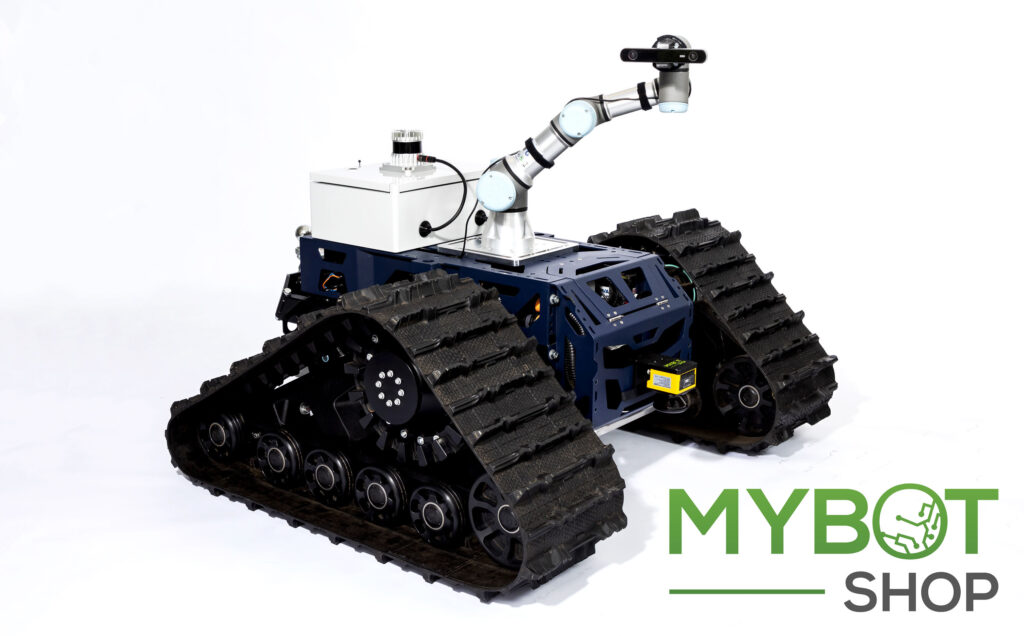
Neben der Basis-Version im bald erhältlichen MYBOTSHOP-grün, gibt es das Kettenfahrzeug auch als voll konfigurierbare und auf Kundenwünsche zugeschnittene Premium-Version. Dabei profitiert der Endkunde von der jahrelangen Erfahrung und Spezialisierung im Bereich der Anwendungsentwicklung und Forschung, die hausintern bei MYBOTSHOP umgesetzt wird. Das bedeutet, dass Zusatzelemente komplett konfigurierbar und bei MYBOTSHOP auf Anfrage erhältlich sind. Somit bekommt der Endkunde dann ein komplett mit Software aufgespieltes und in Haus getestetes Produkt ausgeliefert. Und auch während der Nutzung steht MYBOTSHOP mit seinem Support und zur Wartung beratend zur Seite. Für die ROS-basierte Programmierung wird eine vollständige Dokumentation als Support auf der Website zur Verfügung gestellt.
Das geländegängige und wassergeschützte Fahrzeug (IP 65) überwindet souverän verschiedene Untergründe wie Schlamm, Schnee und Eis, Kies, Schotter und Sand. Ermöglicht wird dies durch den niedrigen Anpressdruck, der auf der Kettenlänge basiert. Die Akkulaufzeit liegt derzeit bei ca. 8 h (abhängig von Geschwindigkeit und Belastung) und die maximale Geschwindigkeit des Fahrzeugs bei knapp 20 km/h. Optional kann ein Modul für die Schnellladefunktion erworben werden. Mit einer Traglast von bis zu 500 kg bietet sich das Fahrzeug besonders als Transportplattform an. Die Zugkraft liegt bei knapp 2 t und via optionaler Anhängerkupplung lassen sich Anhänger und Fahrzeuge problemlos ziehen.
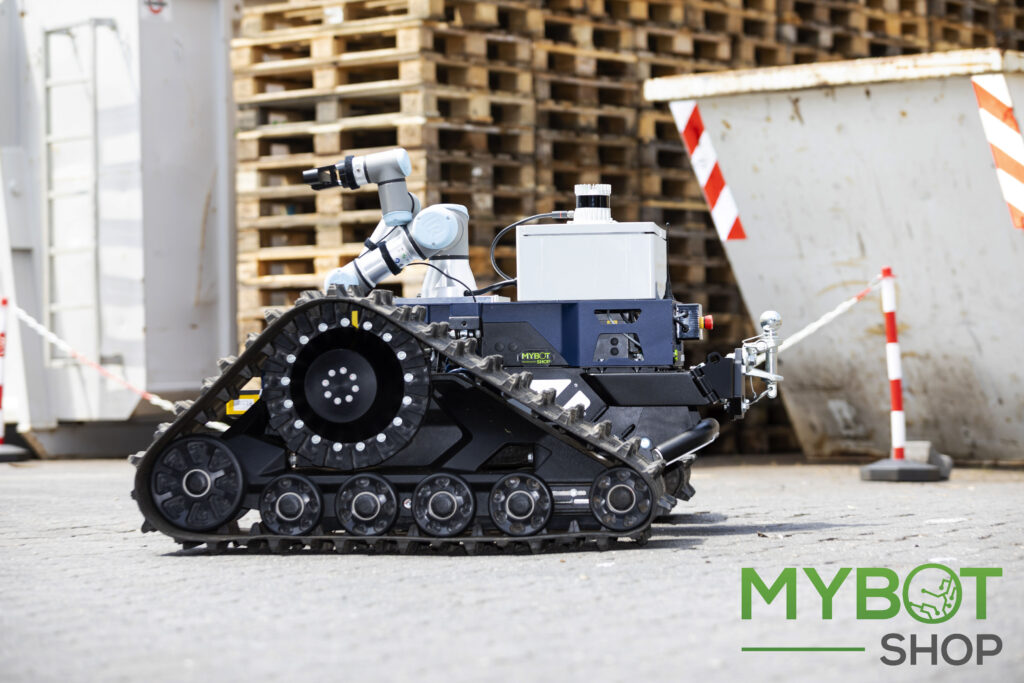
Mittels der externen Spannungsversorgung lassen sich Zusatzverbraucher wie Roboterarme, Kameras, 3D-LiDAR und weitere Komponenten anschließen. Gerade der Ouster 3D-LiDAR bietet sich für das Mapping an, das beim autonomen Fahren unausweichlich ist. Die via Ouster 3D-LiDAR detailgetreue erstellte 3D-Punktwolke basiert auf bis zu 128 Lagen bei einer Winkelauflösung von nur 0,18° und erfüllt dabei alle relevanten Datenschutz-Vorschriften.
Ein Roboterarm, wie der 6-achsige Universal Robots UR-3, ermöglicht unter anderem als Allrounder-Arm die mobile Manipulation.
Empfehlenswert ist die Nutzung eines HOKUYO UAM-05LP – einem sogenannten Safety LiDAR. Dies bedeutet, dass er durch seine TÜV-Süd-Zertifizierung, bzw. seinem redundanten Aufbau, unter anderem in Roboter-Mensch Applikationen eingesetzt werden darf. Dabei arbeitet das System nach dem so genannten ToF-Prinzip (Time of Flight) wobei die Zeit des emittierten Lichts gemessen wird. Infolge dessen sind maximale Messzeiten von 60 ms möglich.
Die verwendete Stereolabs ZED ist eine performante 3D-Kamera für einen breiten Anwendungsbereich. So verfügt diese Kamera über zwei 4 MP Kameras, wodurch 2 K-Aufnahmen (4416 x 1242 px) mit einer Framerate von bis zu 100 Hz ermöglicht werden.
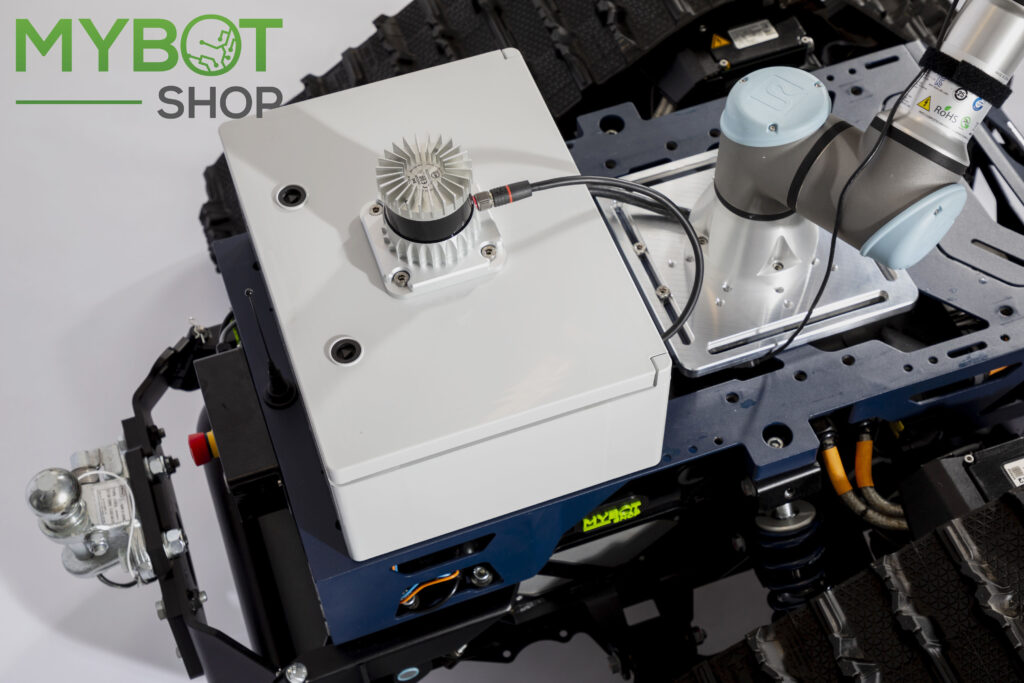
Mit dem MBS ROVO 2 kann MYBOTSHOP ein Produkt anbieten, das durch geringen Wartungsaufwand und eine lange Lebensdauer überzeugt – Preis und Leistung stimmen hier überein. Aufgrund jahrelanger Erfahrung, erprobter Technik, permanenter Weiterentwicklung und Verwendung qualitativ hochwertiger Komponenten im Fahrzeug rentieren sich die Anschaffungskosten in Höhe von 40.000 EUR (UVP). MYBOTSHOP Firmengründer Daniel Kottlarz schöpft aus der autonomen Zukunft und künstlichen Intelligenz das Potenzial, Arbeitsschritte und Prozessabläufe zu vereinfachen und die Kosten-Nutzen-Effizienz zu steigern. Ebenso können Mitarbeiter im gefährlichen Arbeitsumgebungen reduziert und deren Sicherheit unterstützt werden.
Better gripping with intelligent picking robots
Researchers from Germany and Canada work on new AI methods for picking robots.
ISLANDIA, NY, July 7, 2021 — Production, warehouse, shipping – where goods are produced, stored, sorted or packed, picking also takes place. This means that several individual goods are removed from storage units such as boxes or cartons and reassembled. With the FLAIROP (Federated Learning for Robot Picking) project Festo and researchers from the Karlsruhe Institute of Technology (KIT), together with partners from Canada, want to make picking robots smarter using distributed AI methods. To do this, they are investigating how to use training data from multiple stations, from multiple plants, or even companies without requiring participants to hand over sensitive company data.
“We are investigating how the most versatile training data possible from multiple locations can be used to develop more robust and efficient solutions using artificial intelligence algorithms than with data from just one robot,“ says Jonathan Auberle from the Institute of Material Handling and Logistics (IFL) at KIT. In the process, items are further processed by autonomous robots at several picking stations by means of gripping and transferring. At the various stations, the robots are trained with very different articles. At the end, they should be able to grasp articles from other stations that they have not yet learned about. „Through the approach of federated learning, we balance data diversity and data security in an industrial environment,“ says the expert.
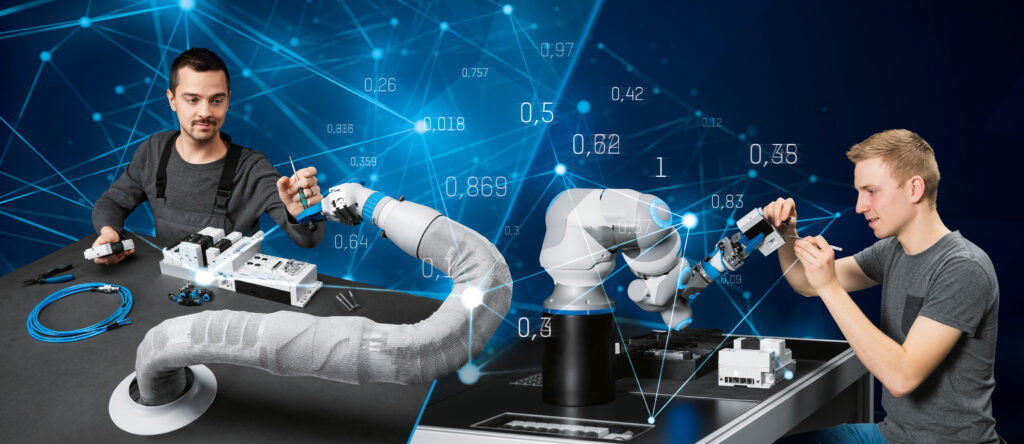
Powerful algorithms for industry and logistics 4.0
Until now, federated learning has been used predominantly in the medical sector for image analysis, where the protection of patient data is a particularly high priority. Consequently, there is no exchange of training data such as images or grasp points for training the artificial neural network. Only pieces of stored knowledge – the local weights of the neural network that tell how strongly one neuron is connected to another – are transferred to a central server. There, the weights from all stations are collected and optimized using various criteria. Then the improved version is played back to the local stations and the process repeats. The goal is to develop new, more powerful algorithms for the robust use of artificial intelligence for industry and Logistics 4.0 while complying with data protection guidelines.
“In the FLAIROP research project, we are developing new ways for robots to learn from each other without sharing sensitive data and company secrets. This brings two major benefits: we protect our customers‘ data, and we gain speed because the robots can take over many tasks more quickly. In this way, the collaborative robots can, for example, support production workers with repetitive, heavy, and tiring tasks”, explains Jan Seyler, Head of Advanced Develop. Analytics and Control at Festo SE & Co. KG During the project, a total of four autonomous picking stations will be set up for training the robots: Two at the KIT Institute for Material Handling and Logistics (IFL) and two at the Festo SE company based in Esslingen am Neckar.
Start-up DarwinAI and University of Waterloo from Canada are further partners
“DarwinAI is thrilled to provide our Explainable (XAI) platform to the FLAIROP project and pleased to work with such esteemed Canadian and German academic organizations and our industry partner, Festo. We hope that our XAI technology will enable high-value human-in-the-loop processes for this exciting project, which represents an important facet of our offering alongside our novel approach to Federated Learning. Having our roots in academic research, we are enthusiastic about this collaboration and the industrial benefits of our new approach for a range of manufacturing customers”, says Sheldon Fernandez, CEO, DarwinAI.
“The University of Waterloo is ecstatic to be working with Karlsruhe Institute of Technology and a global industrial automation leader like Festo to bring the next generation of trustworthy artificial intelligence to manufacturing. By harnessing DarwinAI’s Explainable AI (XAI) and Federated Learning, we can enable AI solutions to help support factory workers in their daily production tasks to maximize efficiency, productivity, and safety”, says Dr. Alexander Wong, Co-director of the Vision and Image Processing Research Group, University of Waterloo, and Chief Scientist at DarwinAI.
About FLAIROP
The FLAIROP (Federated Learning for Robot Picking) project is a partnership between Canadian and German organizations. The Canadian project partners focus on object recognition through Deep Learning, Explainable AI, and optimization, while the German partners contribute their expertise in robotics, autonomous grasping through Deep Learning, and data security.
- KIT-IFL: consortium leadership, development grasp determination, development automatic learning data generation.
- KIT-AIFB: Development of Federated Learning Framework
- Festo SE & Co. KG: development of picking stations, piloting in real warehouse logistics
- University of Waterloo (Canada): Development object recognition
- Darwin AI (Canada): Local and Global Network Optimization, Automated Generation of Network Structures
Visit www.festo.com/us for more information on Festo products and services.
About Festo
Festo is a leading manufacturer of pneumatic and electromechanical systems, components, and controls for process and industrial automation. For more than 40 years, Festo Corporation has continuously elevated the state of manufacturing with innovations and optimized motion control solutions that deliver higher performing, more profitable automated manufacturing and processing equipment.
BeBot, the beach cleaning robot, is the first in the Searial Cleaners product line
If you need a beach cleaner, just ask for BeBot from The Searial Cleaners range. This robot cleans beaches to meet an essential environmental need and drastically simplifies the daily chore. Poralu Marine has developed a product that is perfectly adapted to its clients’ business concerns.
Not only does BeBot help protect the environment, but it does so without polluting: it is the only fully electric beach cleaner on the market, using both batteries and solar panels. It therefore emits no greenhouse gases.
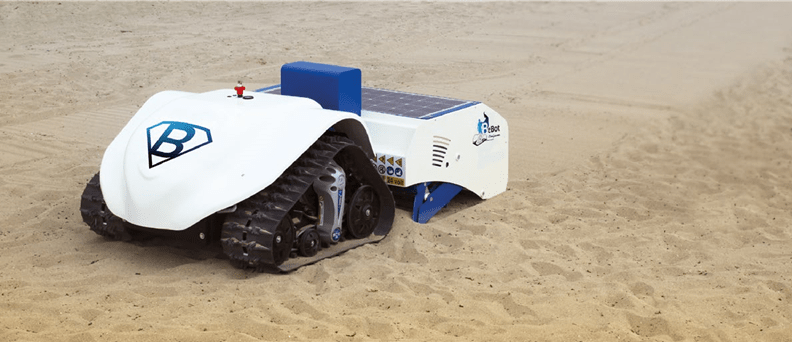
Thanks to its technology, widely acclaimed by the scientific community, it protects fauna buried under the sand, notably turtle eggs. It helps prevent beach erosion and does not weaken beach subsoils.
To fine clean the sand, the cleaner robot is steered by remote control, which helps protect both the user and the environment. This silent multi-purpose robot can pull loads of up to 1000 kg or be fitted with a trailer to transport parasols, deckchairs, and so on. Both easy to use and autonomous, the robot greatly facilitates the work of its users.
BeBot is very quiet and can move around cleaning all day on the beach without disturbing tourists, boaters and people working on the beach.
As part of a framework agreement with the Italian company Niteko, Poralu Marine manufactures, markets and distributes this product throughout the world via a well-established network of partners on every continent.
Start-Up Auxivo AG Launches Educational Robotic Exoskeleton Kit on Kickstarter
The Swiss exoskeleton company Auxivo AG, a spin-off of ETH Zurich and a specialist in industrial exoskeletons has launched a Kickstarter campaign for a new educational exoskeleton kit called “EduExo Pro”.
The EduExo Pro aims to make exoskeleton technology available to students, makers, and hobbyists and make it easier for educators to integrate wearable exoskeleton technology into the classroom. The kit contains all the parts needed to assemble an arm exoskeleton. An accompanying handbook provides theoretical knowledge and guides the user step-by-step through the assembly and programming of the exoskeleton. On Kickstarter, the EduExo Pro is offered for CHF 890. For those who decide quickly, there is a limited number available for 790 CHF. Later, the retail price will be 1090 CHF.
What are exoskeletons?
Exoskeletons are wearable robotic systems that have become increasingly popular in medical and industrial applications in recent years. There they support specific movements and work to reduce the physical workload and prevent injuries. As the technology is still relatively young, there is hardly any possibility to access and learn about such systems outside of professional applications. Auxivo AG would like to close this gap by offering an educational kit to democratize the development of future exoskeletons.
https://www.kickstarter.com/projects/auxivo/eduexo-pro-a-robotic-exoskeleton-kit-for-stem-education
LDROBOT Announces Launch of LD-AIR LiDAR – Ultra-Small & High-Precision TOF Sensor For Robotic Applications
LDROBOT a high-tech enterprise focusing on the research and development of advanced robotics, has announced the launch of LD-AIR LiDAR a ready-to-use compliant laser sensor with 360° sensing capabilities. This affordable LiDAR component makes any robot smarter and is available now on Kickstarter.
The ability to recognize objects and the environment is a key feature of many robots. LiDAR enables robots to scan their surroundings, make highly accurate maps, and navigate freely. Using advanced technology, LD-AIR LiDAR is a high-accuracy TOF sensor with 360° scanning range which is able to sense the surrounding environment by taking up to 4500 laser ranging samples per second to actualize obstacle detection and autonomously map any area.

LD-AIR LiDAR was created to serve business and research purposes that require robot navigation and obstacle avoidance. For robot developers, this essential component makes robots more useful and intelligent at an affordable price.
“In today’s advanced robots, LiDAR sensors are being widely used. The ability to quickly scan an area and create highly accurate maps is essential for applications such as archeology, geography and autonomous cars. And lately, consumer robots are using this technology in creative ways that make smart home applications and service robots smarter. Unfortunately, the cost of highly accurate LiDAR sensors is very high which puts this useful technology out of reach for many. Our goal at LDROBOT Group, was to make LiDAR accessible to everyone by creating a compact and affordable LiDAR with powerful features that is small enough to fit in virtually any device. Now, robotics innovators, makers, and hobbyists can harness the power of LiDAR to make more powerful, useful and convenient robots.”

As an affordable yet full-featured LiDAR solution, LD-AIR LiDAR can be readily applied to the design of working services robots for tasks such as route setting and automatic responsive behaviors. It is a Ready-To-Use compliant laser sensor that is small and versatile enough to fit in any appliance. With an aim toward improving consumer service robots LD-AIR LiDAR has important safety features built-in. It is Certified LD FDA Class 1 Laser Safety Standard, and uses a low power infrared laser light as its light source, effectiveness and eye safety for humans and pets.
LD-AIR LiDAR – Ultra-Small & High-Precision TOF Sensor is available now on Kickstarter with special pricing for early supporters. Learn more here: [Link]
SourceRabbit released a commercial GCode Sender for GRBL CNC Machines
GRBL is quite popular with the CNC hobby community, open source firmware that turns an Arduino into a CNC controller. It was released in 2015 and in recent years has gained many friends, among them SourceRabbit, a Greek CNC machine tool manufacturer, which aspires to transform GRBL from a hobby tool to an industry standard by offering the first commercial CNC control software for GRBL-compatible CNC machines.
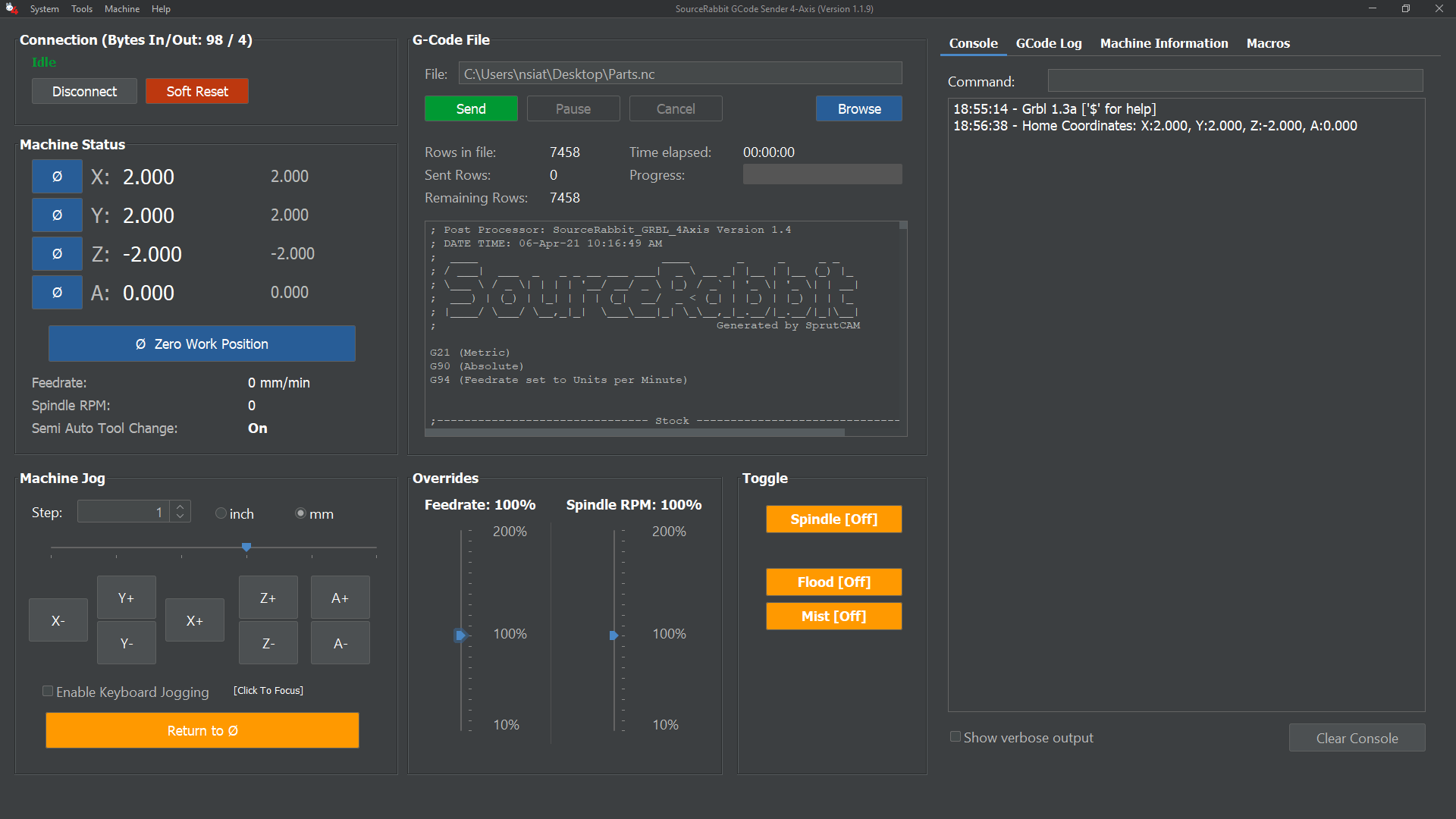
Their new commercial software, GCode Sender 4-Axis, released in April 2021, replaced their old 3-axis software which has been available since 2015. It is compatible with the classic 3-Axis GRBL for AVR processors and the new multi axis Grbl for the Esp32.
We managed to obtain a statement from Nikos Siatras, CEO of SourceRabbit, who told us “From 2015 until the beginning of 2021, many GCode Sender applications were developed to control GRBL CNC machine tools. All of them were open source, free of charge, without any support and often with several bugs that tire even the most patient user. While GRBL is an incredibly good and flexible CNC control firmware, the GCode Senders that existed until today gave the impression that GRBL is purely for hobbyists. Through the development of our own software we are going to change that and we will try to make GRBL a CNC industry standard.”
SourceRabbit plans to implement many new tools and features to the GCode Sender 4-Axis. The software retails for €50.00 + VAT and with the purchase of each license you have free access to all subsequent versions of the software.
